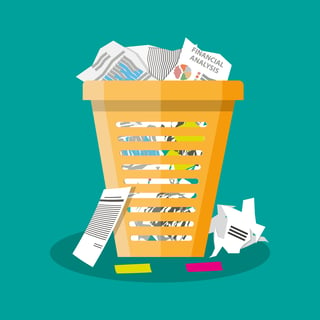 The Lean approach to business management is founded on the principle that anything that doesn’t add value to the customer should be eliminated, or at least minimized as much as possible. It becomes the mission of everyone in the organization from the CEO on down to frontline workers to identify waste and propose incremental improvements that will reduce it.
The Lean approach to business management is founded on the principle that anything that doesn’t add value to the customer should be eliminated, or at least minimized as much as possible. It becomes the mission of everyone in the organization from the CEO on down to frontline workers to identify waste and propose incremental improvements that will reduce it.
There are many tools and techniques, such as value stream mapping, PDSA, the 5 Whys, and others that help achieve this goal. Software solutions designed for the purpose are extremely helpful in managing, maintaining, and calculating the impact of this type of improvement work.
The Types of Waste
The seven traditional wastes of Lean (in no particular order) are:
Transport: Some transportation of product and work in progress is necessary, but each time something is moved it there is the risk of damage, delay, or loss.
Inventory: Work in progress, raw materials, or finished goods that are sit
ting around simply take up space and tie up cash without adding value.
Movement: The waste of movement is similar to the waste of transport, except it refers to people and equipment, rather than product or materials.
Waiting: When one work function is stalled, waiting for input from one downstream, the waste of waiting occurs. This has obvious implications in manufacturing, but it applies to other sectors as well. Imagine a software QA team with nothing to do because development is delayed.
Overproduction: Imagine that customers want to buy 50 of something, but you’ve made 100. The effort and raw materials that went into the excess production are wasted, and the waste of inventory is almost always triggered.
Over-processing: Over-processing occurs when an organization delivers more than the customer is willing to pay for. Adding complexity to products does not always add value, but it certainly can add waste.
Defects: The rule of thumb when it comes to defects, perhaps the most obvious form of waste, is that you can’t add value twice.
Although Lean is traditionally associate with these seven wastes, recently, practitioners have recognized an eighth…
The Waste of Human Potential: In today’s knowledge-based economy, effectively developing and applying intellectual capital is essential to creating value. People in your organization know how to reduce waste, improve productivity and increase profit. When their ideas are unreported or ignored, human potential is wasted.
How Software Can Help
Even the most acutely attuned Lean organizations can benefit from software when it comes to eliminating waste.
Capture Opportunities for Improvement: Implementing a platform for incremental improvement makes it possible for every employee to report waste whenever they see it. They are able to associate all of the necessary documents and images with the opportunity to speed the pace of improvement and ensure that no waste goes unnoticed.
Support the Improvement Process: The best software solutions support improvement by making it easy for managers to form a team, delegate tasks, and track the progress of waste elimination work. Team members receive notifications and alerts so that improvement stays top of mind.
Measure the Impact: It is difficult to keep an entire organization focused on Lean efforts if the results of those efforts are unknown. With Lean software, it is easy to calculate the impact of waste reduction and to report on the progress of the entire company.
There are no hard and fast rules when it comes to seeking out and eliminating the 8 wastes of Lean, but utilizing software to support the effort can go a long way to making all of your other strategies more effective. Fortunately, there are solutions available designed for this specific purpose. Good luck and happy waste hunting!
![The 7 Wastes of Lean [Free eBook]](https://no-cache.hubspot.com/cta/default/326641/b3d32e45-87f5-4557-865f-772d99911733.png)


Add a Comment